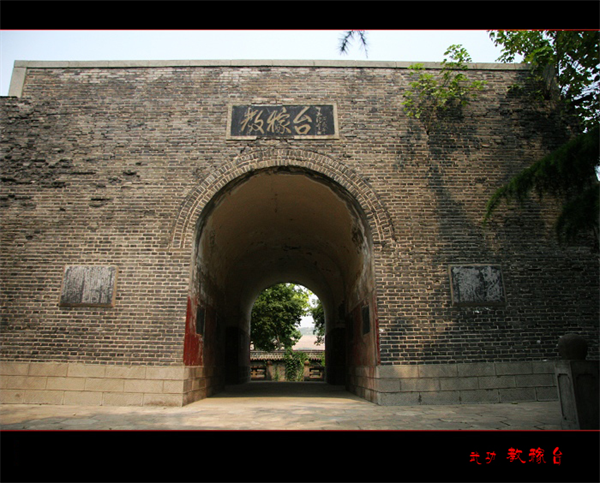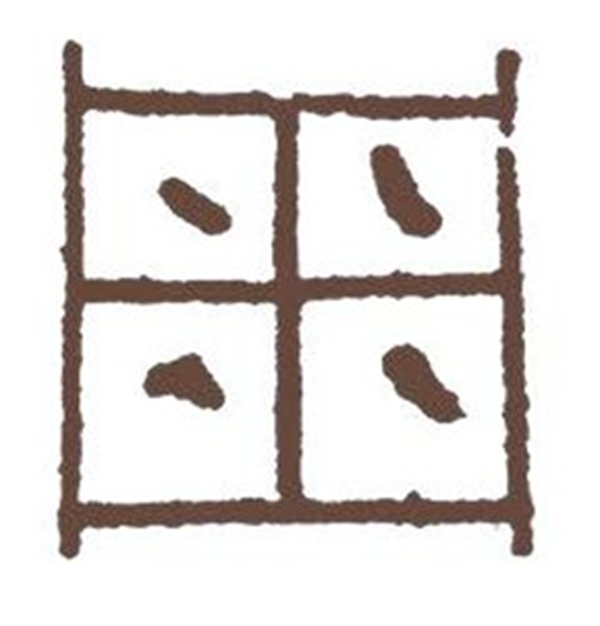Birthplace of Agriculture in China

Jiaojiatai in Wugong County
Recently, both Shaanxi natives and people from other places tend to connect immediately Shaanxi Province with such historic periods as the Zhou, Qin, Han and Tang dynasties. It is because the splendid Shaanxi culture began to set its fingerprint on Chinese history and culture ever since the Zhou Dynasty. You can find the state policy of regarding farming as the basis of state development, the feudal system of running the nation with several affiliating states, the Ritual and Music System featuring bell ringing and using ding as the daily cooking utensil etc. in as early as the Western Zhou Dynasty (1046~771BC). All these made Shaanxi, the birthplace of the Zhou Dynasty, the footstone of the Chinese civilization.
As a nation heavily dependent on agriculture, China has been investing abundantly on farming since the Zhou Dynasty, during which the Zhou People launched the earliest primitive projects to enhance farming in China.
Zhou People is an ancient clan living in the west of Guanzhong Plain, Shaanxi Province. Its ancestor was originally surnamed Qi, which literally means “a child being abandoned or deserted”. Legends have that during the period when Qi was the head, the clan was gradually transformed from a matriarchal society to a patriarchal society. Qi was a good farmer and was said to be invited by Emperor Yao to take over the official position in charge of farming. Qi introduced his planting techniques to local peasants and helped them reap a great harvest, which won him the praise from Emperor Yao.

Character of zhou on oracle bones
After Emperor Shun came to the throne, Qi was appointed member of the irrigation project launched by Yu. Due to his great contribution to farming, Emperor Shun feoffed the State of Tai (the recent Wugong County, Shaanxi Province) to him. Since the feoff was adjacent to Ji River, the Zhou clan accordingly took Ji as the surname henceforward. As he was in charge of farming, he was regarded as Hou Ji, in which the character “hou” means the king and “ji” one common crop in north China. Therefore, Hou Ji means “King of Crop Planters” or “God of Farming”. Recently, you can find a place of interest called Jiaojiatai outside the eastern gate of Wugong township, Wugong County, which is said to be the site where Hou Ji delivered farming techniques to local peasants.
Many archeological findings in Shaanxi were found to prove Zhou People’s dedication to farming and agriculture. The carbonized sorghum found in Changwu County, for instance, proves to be the oldest sorghum specimen in the world, which is of great value in scientific research. In the inscriptions engraved on oracle bones, the character “zhou” is a pictograph resembling an intersected crop field, which actually illustrates it was once a place with developed agriculture and Zhou People were skilled in farming.
Since it was initiated, the primitive farming had been adopted for quite a long time until Zhou People started to revolutionize the aboriginal techniques and applied new methods in farming, which promoted farming in Guanzhong Area and the Yellow River Valley. Thanks to Zhou People’s dedication to farming in Zhouyuan, Guanzhong Area and the Yellow River Valley could take the lead in stepping into the civilized society and become the political, economic and cultural center of China. Hou Ji’s instruction of farming techniques, in particular, was regarded as the earliest recorded promotion and instruction on farming techniques in the Chinese history.
Besides Hou Ji, the first head of the Zhou Clan, Gong Liu, the fourth head of the clan and Gugong Dan Fu, the thirteenth head of the clan are also important figures famous for stressing the importance of agriculture. Their efforts laid a solid basis for the development of agriculture in China. The advanced farming of Zhou eventually led to the fall of the Shang Dynasty. Since the founding of the Western Zhou Dynasty, rulers for several generations continued their support for agriculture, which turned the then capital of Feng and Hao a well-known farming base. In Shijing, the Book of Songs, you can find a great number of poems about farming, which embody the advanced agriculture of the Western Zhou Dynasty and people’s support for agriculture during that time. It can be concluded that Zhou People was a clan engaged in farming and the Western Zhou Dynasty laid the basis for the traditional state policy of “Running the state on the basis of agriculture”.
After Hou Ji, Zhou Clan migrated frequently and eventually settled down in Zhouyuan, South of Qishan County in western Guanzhong Plain, Shaanxi Province. Since their settlement was called Zhouyuan, the clan with the surname of Ji was later called the Zhou People and thus the state they built being called Zhou. In the following century, Zhou People worked hard so that their state accumulated national strength and gradually changed from a little clan to a powerful state “covering about two thirds of the entire country”, which laid the basis for its later defeat of the Shang Dynasty and founding of the Western Zhou Dynasty. King Wenwang of Zhou migrated to Fenghe River Valley and King Wuwang of Zhou settled down in Hao (southwest of the present Xi’an City) and set them as the joint capital later. Shaanxi is therefore the birthplace of Zhou People with the surname of Ji and it is from Shaanxi that the Zhou People prospered and eventually put an end to the dilapidated Shang Dynasty.
Since Zhouyuan was the birthplace of the Zhou People and Qiyi was the capital in the pre-Zhou period, the place held an important position in the lives of Zhou People. All through the Western Zhou Dynasty, Zhouyuan had been the seat of the capital with gorgeous palaces and imposing temples in which a lot of state ceremonies were held. After the Western Zhou Dynasty was defeated, the capital was destroyed in wars, but a large collection of relics and remains were preserved. Archeological excavations from 1976 to 1978 in Zhaochen Village, Fufeng County, Shaanxi Province revealed 15 construction base remains of buildings built in various periods of the Zhou Dynasty, which are the largest construction complex remains found until recently. Around the remains runs a drainage apron 50cm to 70cm wide. The drainage system in the original constructions comprised surface ditches and underground sewers. From the remains, archeologists unearthed various plank tiles and roofing tiles, which were proved the oldest tiles excavated in the world. Architectural ornaments excavated there include not only the common clam shells and carved clam shells but also burnished rhombus white marble carved with leiwen geometrical patterns. The excavation in Zhaochen Village showed that the traditional “court-plus-veranda” architectural mode had taken its shape in as early as the Western Zhou Dynasty. Some of the buildings have roof spans equaling those of the medium-sized halls in the Ming and Qing dynasties, which are really amazing for their existence some 3,000 years ago. In recent years, excavations of the large-sized construction remains in Yuntang, the bronze foundry in Lijiayao, Henan Province, the four-lane road base remains in Qijia Village, Jingdang Township and the bone tool workshop in Yuntang Village, Fufeng County all provided researchers with first-hand data for the distribution of imperial palaces and noble residences, the feoff system, the living conditions of common people, the productivity level, custom and social practices of the Western Zhou Dynasty.

Construction bases for large-sized buildings in the remains of Zhouyuan
Another important finding in the architectural remains of Zhouyuan is the finding of more than 21,000 pieces of bones, tortoise shells and bones used for divination purposes in the Western Zhou Dynasty, of which 293 pieces were found to bear inscriptions of about 900 signs or characters. These inscriptions record the divination results and major events such as wars, sacrificial ceremonies, feoff & awards and astronomical observation and are therefore precious data for studies into the lives and ideology of the Zhou People. Among these bones and shells, archeologists found some shells bearing divinatory symbols in even or odd number combinations, which were used to explain natural phenomena or to predict the fate of people. This actually laid the basis for the traditional bagua, the Eight Diagrams in Chinese Mythology, in China which features yin and yang, the two opposing principles governing life in nature.
From 2004, large-scale excavation was conducted in Zhougong Temple, Qishan County, which was later regarded as one of the greatest archeological findings in China for its remarkable achievement. It has already been proven to be a large-sized bomb site with the highest rank in the Western Zhou Dynasty and possibly the tomb for Zhougong’s family. The site covers about 80,000m2 and is located on a ridge at the southern foot of Qishan Mountain. Around the tomb site, archeologists found a circumvallation extending about 1,500 meters, which is of great importance in the history of archeological excavation and the history of architecture in China. Additionally, excavation revealed 10 large tombs with four paved paths leading to the tomb and 1,000 plus medium and small-sized tombs, which provide data for research into the burial system in the Western Zhou Dynasty. Excavation of the tombs revealed inscriptions of 2,200 plus words, recording anecdotes about such historic figures as Wang Ji, Zhougong, Zhaogong,Bigong and events covering sacrificial rituals, wars, numerical divination system, memorial dates, phase of the moon, dream divination, divination wording and systems of inscriptions on bones and tortoise shells etc. These findings make Zhougong Temple Remains stand out as the archeological site with the largest number of oracle bone inscriptions. The findings of the remains are, therefore, of unmatchable value for studies into the splendid Chinese civilization and its development.
Since the Han Dynasty, hundreds of bronze caches have been found around Zhouyuan Area. Among the discoveries, two of the “Four National Treasures of China”, i.e., Dayu ding and Maogong ding were excavated in the Qing Dynasty. Apart from these findings, various bronze vessels including the well-known Dake ding, Xiaoke ding, Shizai ding, Wei ding, Wei he, Zhen yi, Dong gui, Hu gui, Xing bell, Shiqiang plate, Zhe gong, Xing hu etc. were also unearthed here. Shaanxi is nicknamed “home to bronze vessels”, which is largely due to the glorious achievements in bronze vessel production in the Zhouyuan Area.


